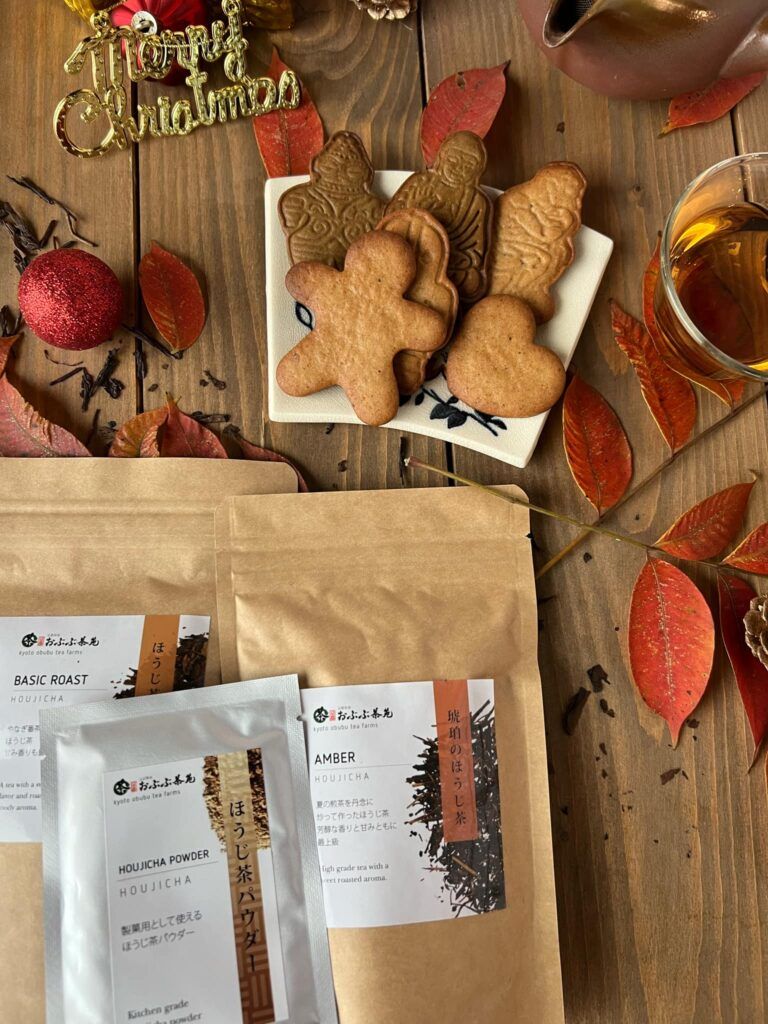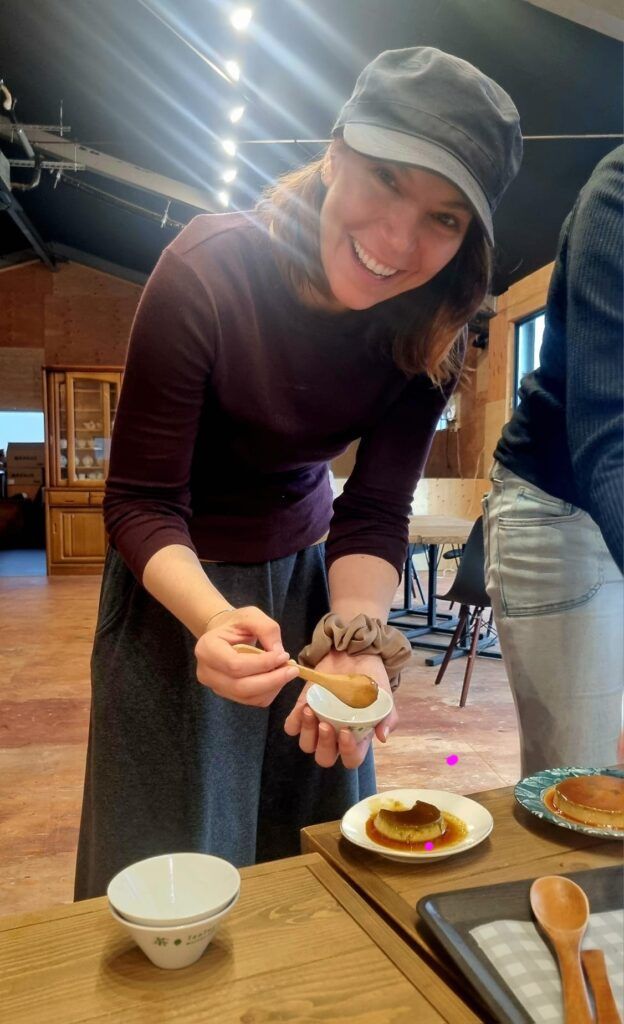Clover Tan

When deciding on my project, I was inspired to combine Japanese tea with Christmas desserts, a pairing not often associated with the holiday season. I thought this unique twist could add to the festive vibe and offer a fresh way to enjoy the holiday spirit. I’ve always believed that taste has the power to evoke memories and help us relive special moments. By blending the comforting flavours of Christmas with the delicate notes of Japanese tea, I hope to create something that warms both the heart and the senses.
To make this project even more meaningful, I chose to bake traditional Christmas desserts from the home countries of our wonderful assistant managers at Obubu. Since they’ll be spending a year away from their families, I wanted to bring them a taste of home through these festive treats. My hope is that the familiar flavours and aromas will remind them of cherished holiday memories and make this Christmas feel a little warmer, even while they’re far from home. It’s a small way to share the spirit of the season and show appreciation for all they do.
I asked each of them their favourite Christmas dessert from home and started crafting ideas on flavours and tea pairings. After some discussions with the assistant managers and my research online, I settled on the following four types of Christmas desserts and the tea pairings. For this baking project, I have mostly used recipes found online and made subtle adjustments to include Obubu cooking tea powders.
Latvian Pepper Cookies with Houjicha
Latvian pepper cookies, or Piparkūkas, are a traditional holiday treat known for their blend of warm spices like cinnamon, cloves, cardamon and black pepper. I thought the warm and comforting flavors of the cookies will be a perfect match with the roasted and nutty notes of our Houjicha Powder. These warmly spiced cookies holds cherished memories for Katrina, our newest assistant manager from Latvia.

“Sometimes, we make it together in the family or with a group of friends and have a lot of fun!” Katrina chirped as she reminisce those memories. She then joined me in rolling the cookie dough and cutting them with those funny cookie cutters.
When the cookies were baked and cooled, she turned into a cookie monster and started gobbling down a few. I then had to hide them away in order to save it for the photoshoot. But it was really fun seeing her giggling like a little girl while asking for more. “The flavor is really authentic and the houjicha ones taste great too!” she chirped again.
Spanish Flan with Genmaicha
Spanish flan is a classic dessert celebrated for its creamy, smooth texture and rich caramel flavor. Made with simple ingredients like eggs, milk, and sugar, the flan is a timeless favorite to be enjoyed. For that, I have chosen to use Genmaicha Powder in this dessert to balance the delicate sweetness of the flan and the tea’s light, earthy character.
Sarah McDaniel, or Mac (as we affectionately calls her) is from Arizona in USA. She shares with me her childhood memories of visiting her grandparents and enjoying homecooked Spanish food. Among all, a favorite that she picked, is the Flan. “This is aamazzinggg…! It looks perfect!” exclaimed Mac (who is always generous with her compliments) when she saw the flan that I have successfully dished out from their ramekins. “It really does taste like home..” she said after trying the original flavor. I think the Genmaicha flavored flan also stood out as the toasty undertones of the tea provided a balanced and refreshing accompaniment to the creamy dessert.
Italian Panpepato with Wakoucha

Panpepato, meaning “peppered bread” is a traditional spiced cake originating from central Italy, particularly popular during the holiday season. Made with a mix of nuts, dried fruits, cocoa, and warming spices, it offers a rich and dense flavor profile which Marcello describes as “大人っぽい” (otona poi) or adult-like. He continued to share with me about the dessert and also contributed his secret recipe from home. But of course, I did not follow it entirely as I wanted to experiment blending in the sweet rounded flavors of Wakoucha Powder.
After 1 hour of baking, 2 days of drying and 3 layers of chocolate glaze, my first Panpepato was made. It resembled a rock.
Me: “Is it supposed to be this hard?” *knocking on it*
Marcello: “Yes, it is!”
Ok, let’s trust the true Italian, who is also an avid foodie and aspiring cook, I thought. While the making of this dessert was relatively straightforward, the hardest (literally) part was cutting them into thin slices, just like biscotti. Luckily for me, Marcello took over the job of slicing while I shared the fruity spiced cake slices with other team members at Obubu.

I could really taste the Wakoucha! Perhaps, I added too much! Oops.. but the slight bittersweetness of the Wakoucha seems to blend well with that of the dark chocolate. I could absolutely imagine having it as a tea time snack together with a cup of Tsugumi Kukicha or Dark Roast Houjicha (in my rocking chair with a classic read).
Bûche de Noël with Wakoucha whipped cream and Chestnuts
Bûche de Noël, or Yule Log, is a classic French dessert traditionally served during the Christmas season. This sponge cake is rolled to resemble a log, filled with cream, and most commonly decorated with chocolate frosting and powdered sugar that looks like “snow”. Alix, who is from the North of France went with Bûche de Noël right away when being asked of a French Christmas dessert. She had zero hesitation. It clearly shows how this dessert is synonymous to Christmas for the French.
For this recipe, I only added a subtle amount of Wakoucha Powder to the whipped cream and leave the other components of the cake as it is. “Sometimes, less is more.“ I thought. It is not always necessary to stand out and be the highlight. Much like the viola or double bass in an orchestra, which are accompaniment more than the main melody. It is also about allowing them to work in harmony and balance rather than overpowering one another. This christmas cake proves to be a crowd pleaser with the amount of compliments from everyone who tried it. Merci!
When working with flavor pairing and blending, balance is key. Just like working with people. To each has their own characteristics and imperfections, the balance of different elements in adequate amount is essential. Sometimes, flavors blend in perfectly as desired, but other times, it may require adjustments and compromise to achieve a better harmony of taste. Regardless, the process of creating is always a journey to be enjoyed. I want to continue experiment baking with tea, using senchas and loose tea leaf in the future.
It was really a pleasure to see the lit-up faces of people when they truly enjoyed and appreciated the sweets I have created, especially the assistant managers (Katrina, Mac, Marcello and Alix) who got a taste that reminded them of home. Thank you for sharing your stories with me! It also meant a lot to me that they were able to feel joy simply with those treats.

Thank you so much.
For the simple joy I had, and I wish for everyone.
Merry Christmas!
Clover







